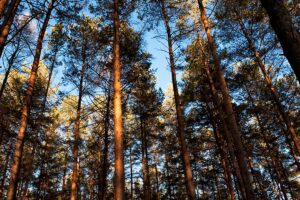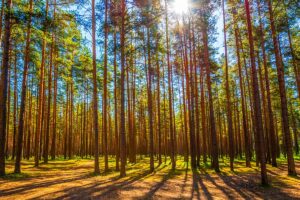Phone calls and emails come in waves tied to worries about markets or exuberance related to investment opportunities. Recently, questions often focus on the state of timber and timberland markets in the U.S. South. Why? From 2009 through 2016, U.S. housing starts increased 112%, a compound annual rate exceeding 11%. Over this same time, U.S. softwood lumber consumption increased 55% and average annual pine sawtimber prices in the U.S. South…wait for it…declined 10%. Housing is up! Lumber use is up! But prices are down?
This apparent disconnect between housing and stumpage prices does line up with the physical facts on the ground associated with forest supplies and wood demand. An understanding of current situation lays the groundwork for assessing current and future timber prices in the South.
Factors Affecting Timber Prices
Each quarter, Forisk back-tests and updates timber price models to evaluate local timber markets and wood baskets across the U.S. Here are six key factors affecting the responsiveness of timber prices to changes in demand in the South:
1. Substitution
Southern lumber markets are subject to two forms of substitution in the near-term. First, homebuilders in the South can substitute lumber from Canada or the U.S. West for sticks sawed in the South. While the Southern production growth rate outpaced imports from 2010 through 2012, imports outpaced Southern production from 2013 through 2016. This trend is shifting back, we note. Second, we shift and substitute end uses. During the recession, we built fewer homes and did more remodeling and repaired the homes we had. In 2010, repair and remodeling (R&R) accounted for 29% of U.S. softwood lumber applications, exceeding the 26% for new construction. In 2016, new construction accounted for 37% of softwood lumber applications, while R&R declined to 26%. In short, building new homes does not secure a one-for-one increase in lumber production or consumption.
2. Technology
Technology improvements affect both sides of the forest industry equation. We grow wood better and faster than ever. At the same time, yields at industrial softwood sawmills – those producing 100+ million board feet per year – have improved nearly 20%. We project U.S. sawmills in the South will blow through their historic production records by 2019 and use less wood doing it. With the closing of the weakest mills over the past twenty years, today’s “average” sawmill gets closer to NASCAR than a used car.
3. Supplies
We have been studying and quantifying the supply “overhang” in the South since 2012. Three drivers suggest higher levels of accumulated forest inventories than previously estimated:
a.) Forest growth rates: borrowing the math of compound interest, a forest with net growth of 3% could double in 24 years, while a forest with net growth of 4% could double in 18 years. Advances in silviculture and forest management indicate we have made small improvements each and every year in the South for the past 50 years. And these effects would be compounded by…
b.) Harvest patterns: during the housing boom in the 1990s and early 2000s, the pine sawtimber harvests actually exceeded net growth for a period of time. This is normal. However, the timing affects supplies today. Increased clear-cutting led to increased planting which primed the pump for additional pine grade volumes to grow and accumulate today and tomorrow.
c.) Sawmill yields: revisiting technology reminds us that improved efficiency increases forest supplies on a “relative” basis, as well. And these improvements, like growth rates, compound. If we grow more at a faster rate, and use less at an improving rate, then the spread between growth and removals can expand.
4. Utilization
Regardless the concerns about the slow pace of timber price recovery, we remain at relatively low levels of demand. Softwood lumber production in the South JUST returned to 2003 levels in 2016. And housing remains ~20% below the long-term expected trend. So meaningful upside remains. We are just getting the demand flows and utilization rates that start to tighten the string.
5. Anxious Sellers
A period of lower prices and delayed harvests can create anxiety or a compelling need to sell trees. [In our forest finance workshops, the most popular case studies over the past five years have been those associated with the “marginal harvest decision”; should we harvest now or wait for prices to rise?] Overall, we observe ready sellers and ideal harvest conditions can combine to dampen timber prices. This is especially true in a well-supplied region that, unlike the Pacific Northwest, lacks a robust, string-tightening log export market.
6. Disciplined Buyers
At the moment, softwood lumber margins in the South are the highest of all North American regions, thanks to cheap logs, efficient logging systems and lower cost labor. Sawmill operators have been reallocating capital and production to the South for over ten years, anticipating the strategic benefits of the region for long-term profits and sustainability. Thanks to factors detailed above, disciplined firms recognize the current situation as a clear, buyer’s market.
This content may not be used or reproduced in any manner whatsoever, in part or in whole, without written permission of LANDTHINK. Use of this content without permission is a violation of federal copyright law. The articles, posts, comments, opinions and information provided by LANDTHINK are for informational and research purposes only and DOES NOT substitute or coincide with the advice of an attorney, accountant, real estate broker or any other licensed real estate professional. LANDTHINK strongly advises visitors and readers to seek their own professional guidance and advice related to buying, investing in or selling real estate.









Thanks Brooks. Regarding substitution, I see a lot of framing being done with steel rather than 2×4’s. I also see very cheap construction employing framing, TYVEK and vinyl siding, thats all. That type of construction should be added to the three little pigs story. Fires are not so much of a problem because the house melts before the fire gets there!
Brian: thank you for the comment. We’re tracking those substitutions by volume, and the steel numbers still look “modest” with some pick up in wood for commercial, while the other products you mention do appear to gain traction and we don’t have the history to project. We will watch those; clearly important, thank you. [I hate it when things other than candles or chocolate end up melting; ugh.]
One factor often missing from discussions is the amount of southern lumber that is pressure treated. Several years ago a friend at a large pine sawmill told me that 60% or more is SYP is sold to treaters. And I note that almost all SYP offered by the bog box retailers is treated.
In line with the substitution theory, My house and most new houses I visit are built with SPF, with very little SYP.
Maybe the fact that SYP is not a MAJOR component of housing factors in.
Robert: agreed on treating. The treating factor splits the market in a different way; all lumber products do not (currently) serve all needs. Re SPF: each month, I walk the aisles at the big box stores locally to see where lumber came from (and what it costs); even for large firms with billions of board feet of capacity in the South, some of their mills north of the border still get some SPF volume down here. Thank you for taking the time to read and respond.